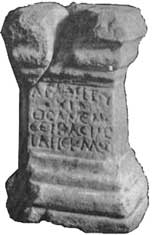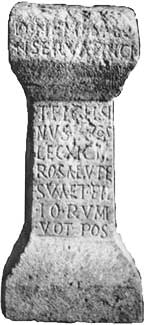
Decree honoring Diophantos
Inscription honoring the emperor Zeno
Civic Oath of Chersonesos
Decree honoring Syriskos the historian
Base of statue for Agasikles
Proxeny decree for an ambassador from Mithridates Eupator
Decree honoring ambassadors from Herakleia
Base of statue for Aristonos
Treaty of alliance with the king Pharnakes I
List of those who won sport competitions
Inscription about the tax on prostitution
Fragment of a decree about the fortress of Napites
Inscription about construction of a city gate
Dedication to the goddess Nemesis
Inscription regarding the liberation of Kalos Limen
Decree honoring the emperor Marcus Aurelius
Decree honoring Gaius Julius Satyrus
Proxeny for a citizen of Sinope
Epitaph in verse on stele for Xanthos
Inscription on the stele set up by doctor
Epitaph in verse on stele for Oinanthe
Short epitaphs
Original publication and commentary by Solomonik
It is a small white marble altar with Greek inscription. It was discovered in 1964 in the area of the ancient theater and dated to the second half of the 2nd century A. D.
"Good fortune! Basileides son of Kalos (dedicated) to the goddess Nemesis."

This altar of local Sarmatian limestone with Latin inscription was found in 1957 during excavation of the ancient theater and dated to the 2nd or 3rd century A. D.

"To goddess Nemesis the Protector.
Titus Flavius Celsinus, beneficiarius of consularis of the Eleventh Claudian legion, set up this by vow for the salvation of himself and children".
Commentary:
Nemesis - the goddess who personified destiny, determined retribution for people according to their gilt. In the imperial Rome, she was worshipped as patroness of gladiators and soldiers. Both Chersonesos altars were discovered in the area of the theater. Nemesis was the goddess of justice, so the Chersonesites might value this of her functions high, as their theater might possibly house people's assemblies and trials side by side with performances.
Titus Flavius Celsinus was not an ordinary soldier but a beneficiarius. This was the name of a privileged category of soldiers, who were free from being on guard, digging, and foraging. Originally, beneficiarii were orderlies of province governors, and in the 2nd and 3rd centuries A. D. they became commanders of special type military posts both in and out camps, which were arranged throughout the Roman empire. When the Romans were establishing a new province, they, first of all, tried to arrange communications and built roads suitable for transportation of the army, equipment, and food between separate places where their troops were stationed. Within the camps, posts of beneficiarii were military offices though outside, on the crossroads, these posts provided secure traffic and were a chain that connected the camps. There, small sanctuaries were built to provide divine protection for the warriors in strange land. Archaeological investigations have discovered altars of beneficiarii, which are reliable milestones to reconstruct an elaborated system of Roman roads.